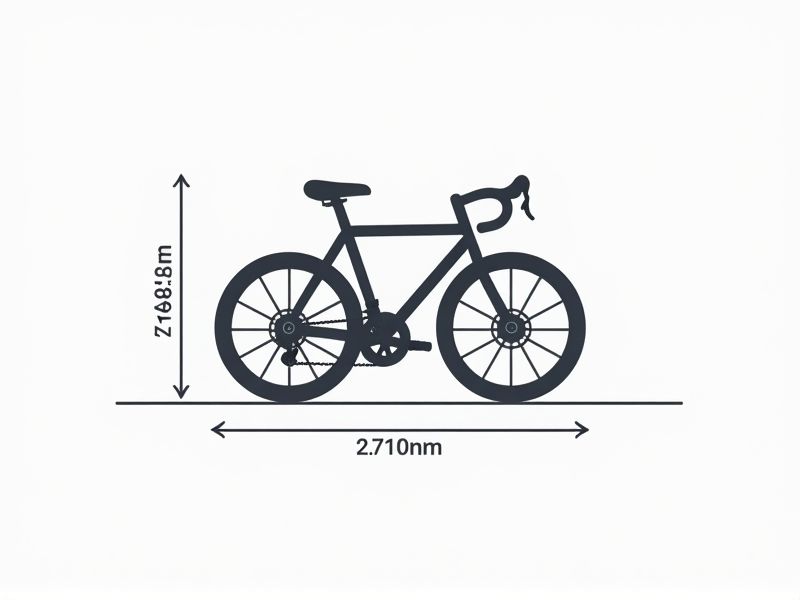
The standard dimensions of a bicycle can vary based on its type, such as road bikes, mountain bikes, or hybrids, but some general measurements are widely recognized. Most adult bicycles have a wheel diameter of either 26 inches or 700c (about 27.5 inches), and frame sizes typically range from 15 inches (small) to 22 inches (extra-large), measured from the center of the bottom bracket to the top of the seat tube. The handlebar width usually matches shoulder width, falling between 38 and 44 centimeters for road bikes. When choosing a bicycle, considering these standard dimensions alongside your height and intended use will help ensure a comfortable and efficient ride.
Wheel Size
Bicycle wheel size significantly influences your riding experience, with common diameters being 26, 27.5, and 29 inches for mountain bikes, while road bikes typically use 700c (approximately 27 inches). A larger wheel size, such as 29 inches, provides better obstacle absorption and improved rolling efficiency over rough terrain, making it ideal for off-road cycling. Alternatively, smaller wheels, like the 26-inch ones, offer enhanced maneuverability and quicker acceleration, which can be advantageous in tight spaces. When choosing your bicycle, consider how wheel size aligns with your desired riding style and the types of trails or roads you plan to encounter.
Frame Size
The frame size of a bicycle is crucial for ensuring comfort and efficiency during rides. Typically measured in centimeters, frame sizes range from 13 inches for small riders to over 21 inches for taller individuals. A properly fitted frame enhances your cycling performance by allowing optimal power transfer and better handling. Choosing the right frame size can significantly reduce the risk of discomfort or injury, making it essential for both recreational and competitive cyclists.
Handlebar Width
The optimal handlebar width for bicycles typically ranges from 38 cm to 44 cm for road bikes, with a wider width supporting better control and aerodynamics during rides. Mountain bikes often feature broader handlebars, measuring between 720 mm and 800 mm, to enhance stability on rough terrains. Personal comfort and riding style significantly influence your choice; narrower handlebars can benefit cyclists seeking aerodynamic positions, while wider options provide improved leverage and maneuverability. Consider your body measurements and riding preferences to ensure the best fit and enhance your overall cycling experience.
Stem Length
The stem length of a bicycle typically ranges from 60mm to 150mm, depending on the rider's height and intended use. A shorter stem, around 60-90mm, often provides improved handling and maneuverability for mountain biking, while a longer stem, like 110-150mm, can enhance stability and comfort during road cycling. Choosing the appropriate stem length can significantly affect your riding posture; a longer stem generally leads to a more stretched-out position, which is beneficial for aerodynamics. For optimal performance, you should select a stem length that complements your body dimensions and riding style, ensuring comfort and efficiency on every ride.
Crank Length
Crank length typically ranges from 165mm to 175mm, influencing your cycling performance significantly. Shorter cranks are often recommended for smaller riders or those with flexibility issues, while longer cranks can benefit taller cyclists by promoting an effective power stroke. A 10mm difference in crank length can impact your pedaling efficiency and comfort during long rides. By selecting the appropriate crank length, you can enhance your overall cycling experience and power output.
Seat Tube Length
The seat tube length of a bicycle is a crucial measurement that affects rider comfort and efficiency, typically ranging from 12 to 25 inches (30 to 63 cm) depending on the bike size and design. This length directly influences the rider's saddle height and leg extension during pedaling, allowing for optimal power transfer and reducing the risk of injury. A properly sized seat tube ensures that you achieve a more aerodynamic position, enhancing speed without compromising comfort. For competitive cyclists, precise adjustments in seat tube length can lead to significant performance gains, underscoring its importance in bicycle geometry.
Top Tube Length
The top tube length of a bicycle plays a crucial role in determining the bike's fit and performance, typically ranging from 510 mm to 650 mm for various frame sizes. A shorter top tube length enables a more upright riding position, ideal for comfort during leisurely rides, while a longer top tube promotes a more aerodynamic posture, beneficial for racing. It's essential to match the top tube length to your body measurements; a proper fit can enhance pedaling efficiency and reduce fatigue. When choosing a bike, always consider testing different top tube lengths to discover the best alignment with your riding style and physical dimensions.
Chainstay Length
Chainstay length, typically ranging from 400mm to 450mm, significantly influences your bicycle's handling and stability. A shorter chainstay enhances maneuverability, making it easier to navigate tight corners, ideal for racing scenarios. In contrast, a longer chainstay provides improved stability and comfort during long rides, suitable for touring and endurance cycling. Understanding these dynamics can help you select the best bike for your specific riding style and preferences.
Bottom Bracket Height
Bottom bracket height is a critical measurement in bicycle geometry, influencing handling and stability. Typically, bottom bracket heights range from 11 inches (280 mm) to 15 inches (380 mm), with variations depending on the type of bike, such as road, mountain, or hybrid. A higher bottom bracket improves clearance over obstacles, while a lower setting enhances aerodynamics and stability at high speeds. When choosing a bicycle, consider how bottom bracket height aligns with your riding style and terrain preferences for optimal performance and comfort.
Fork Length
The fork length of a bicycle, typically ranging from 390 mm to 480 mm, significantly influences the bike's handling and stability. A shorter fork length enhances maneuverability, making it ideal for urban cycling and tight corners. Conversely, a longer fork length improves straight-line stability, which is particularly beneficial for road bikes or long-distance rides. Understanding fork length can help you choose a bicycle that best suits your riding style and conditions.
